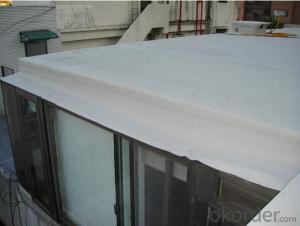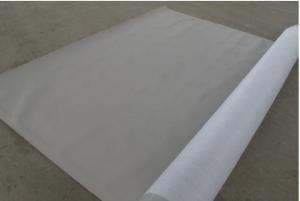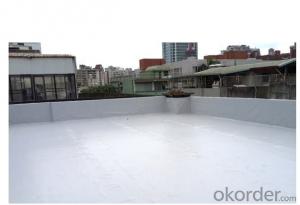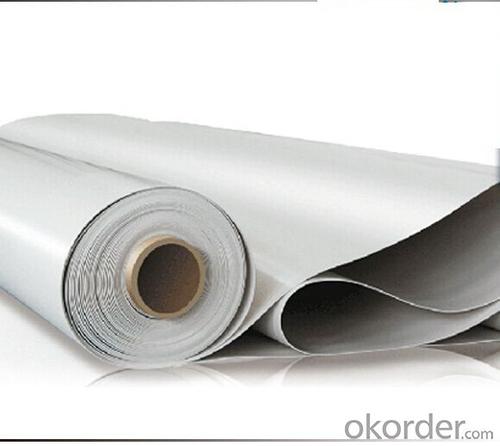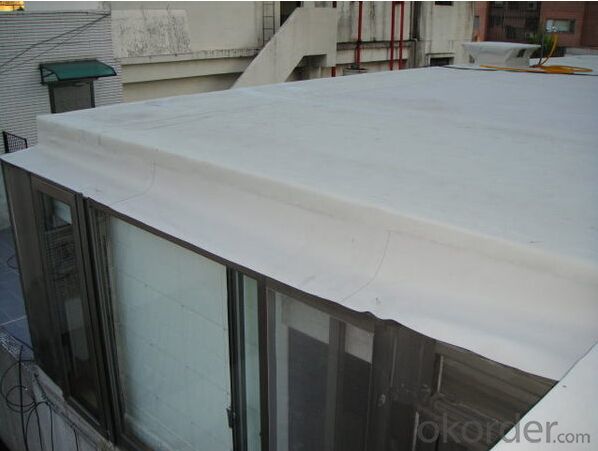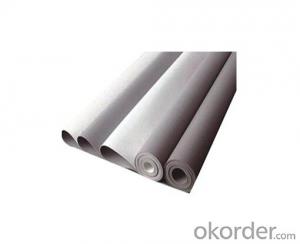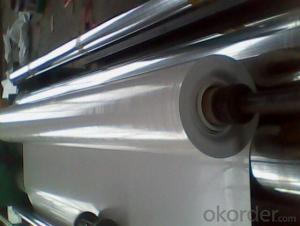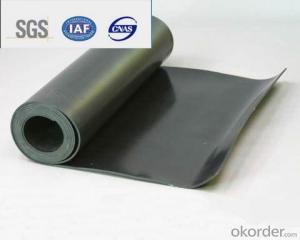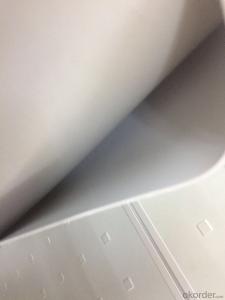PVC Roofing Waterproof Membrane with 1.2mm
- Loading Port:
- Qingdao
- Payment Terms:
- TT or LC
- Min Order Qty:
- 2500 m²
- Supply Capability:
- 350000 m²/month
OKorder Service Pledge
OKorder Financial Service
You Might Also Like
Introduction of PVC Waterproof Membrane
Polyvinyl Chloride (PVC) waterproof membrane is a new polymer waterproof membrane. The raw material is polyvinyl chloride resin, mixed with plasticizer, filler, antioxygen, ultraviolet absorber and other auxiliaries.
Features of PVC Waterproof Membrane
1)Excellent aging resistance. Service life of roofing material is over 20 years; service life of underground material is over 50 years.
2)Root resistant penetration, specially used on planting roofings.
3)Welding installation. Joints are solid and environment friendly, no pollution.
4)High tensile strength, good elongation and dimensional stability.
5)Good plasticity, easy and suitable for details installation.
6)Fireproof. Fire extinguished out of the ignition resource.
7)Surface is smooth, no fading and dirty resistant.
8)Width is over 2m. Construction wastage is small, more economical.
Classification and Specification of PVC Waterproof Membrane
N: Homogeneous PVC membrane
L: PVC membrane with fabric backing
W: Reinforced PVC membrane
Thickness: 1.2mm/1.5mm/2.0mm
Size: 2.05mx20m
Color: white/grey, or any other colors.
Application of PVC Waterproof Membrane
PVC waterproof membrane forms an effective barrier to liquid water or water vapor in the steel structure for industrial and civil engineering, underground engineering, such as subway, bridges , tunnel, water pools, shelter, grain depot, land filling and subway.
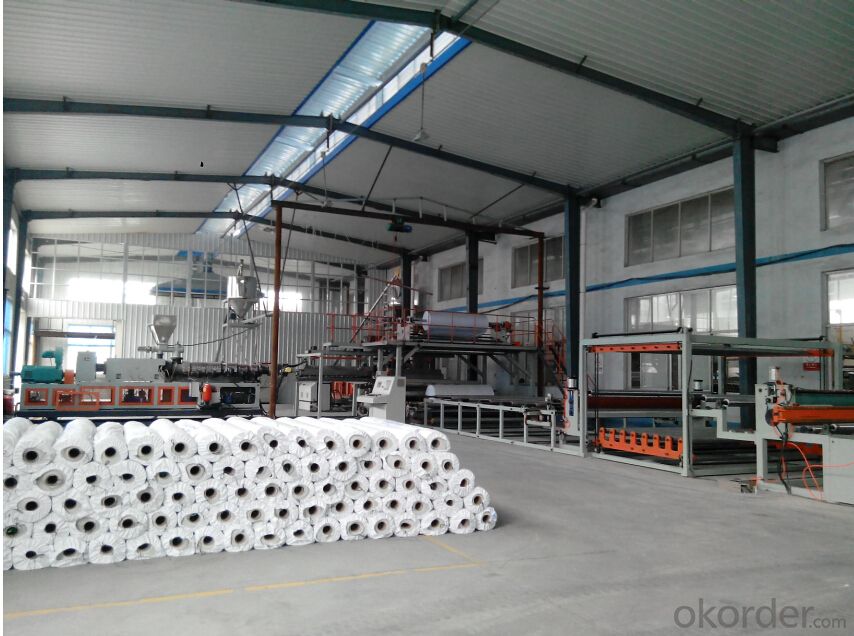
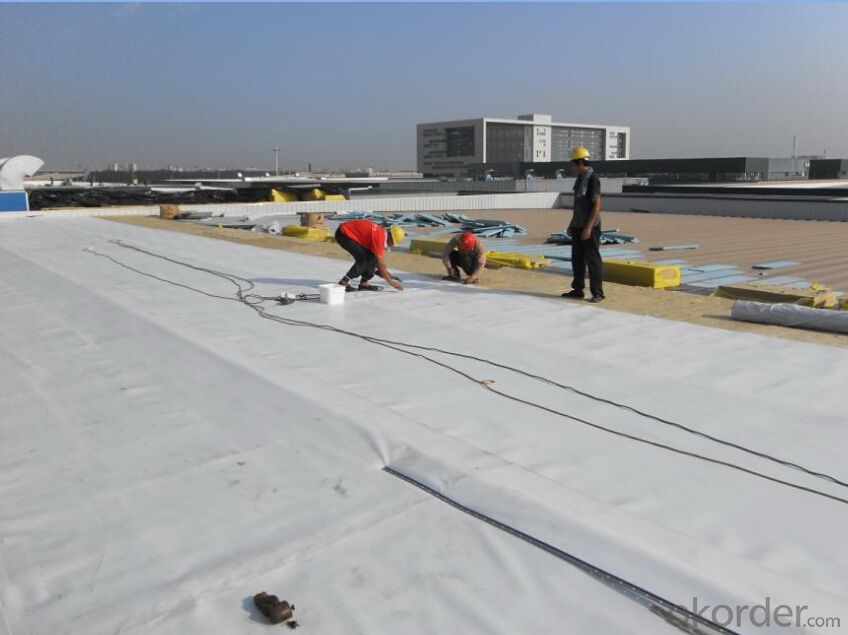
FAQ:
Can you produce 4m width?
Yes, no problem for us. We have four bases in China, largest one in this field.
How many quantity in one 20'' container for 1.2mm and 1.5mm?
480rolls, 11520m2 for 1.2mm and 400rolls, 9600m2 for 1.5mm
Can you provide free samples?
Yes, our samples are free, but express fees usually on buyer's account.
- Q: Are waterproofing membranes resistant to high-pressure water jets?
- Waterproofing membranes are known for their ability to resist high-pressure water jets. They are specifically designed to create a barrier against water penetration and undergo testing to ensure their durability against different water pressures. The level of resistance may differ depending on the type and quality of the membrane. Nonetheless, waterproofing membranes are engineered to withstand high-pressure water jets, effectively safeguarding against water infiltration and potential harm to the underlying structure.
- Q: Can a waterproofing membrane be used on insulation surfaces?
- Indeed, one can apply a waterproofing membrane to insulation surfaces. In fact, it is often advised to incorporate a waterproofing membrane above insulation as an extra layer of defense against water infiltration. This is particularly crucial in areas where moisture poses a concern, such as basements, roofs, or exterior walls. The waterproofing membrane functions as a barricade, preventing water from permeating the insulation and causing harm. It also aids in preserving the insulation's integrity and effectiveness by keeping it dry. Furthermore, certain waterproofing membranes have the added advantage of enhancing the insulation's energy efficiency by reducing air leakage and heat transfer. All in all, utilizing a waterproofing membrane on insulation surfaces is an intelligent and practical solution to safeguard your building or home from water damage.
- Q: BS waterproofing membrane is modified? There are not a few thick drawings, how to do
- For example, class Ⅱ waterproof basement waterproof, if only a SBS waterproofing membrane, then its thickness requires 4 mm; if there are other waterproof layer, you can use 3mm.
- Q: Can a waterproofing membrane be installed underneath tile or other flooring materials?
- Yes, a waterproofing membrane can be installed underneath tile or other flooring materials to protect against moisture and water damage.
- Q: Does a waterproofing membrane prevent water infiltration through concrete or other building materials?
- Yes, a waterproofing membrane is designed to prevent water infiltration through concrete or other building materials. It acts as a protective barrier that is applied to the surface of the material, forming a water-resistant layer. This membrane can be made from various materials such as bitumen, rubberized asphalt, or liquid polymers. When properly installed, it can effectively prevent water from seeping through the concrete or other building materials, thus protecting the structure from potential water damage or moisture-related issues.
- Q: Can a waterproofing membrane be used for plaza decks?
- Yes, a waterproofing membrane can be used for plaza decks. Plaza decks are typically outdoor spaces that require protection from water infiltration to prevent damage to the underlying structure. Waterproofing membranes are designed to create a barrier that prevents water from seeping into the deck and causing issues such as leaks, deterioration, and structural damage. These membranes are often made of materials such as bitumen, rubber, or polyurethane, which are highly resistant to water penetration. By installing a waterproofing membrane on a plaza deck, it ensures that the deck remains watertight and protects the integrity of the entire structure. Additionally, these membranes can also provide added benefits such as UV resistance, durability, and ease of maintenance, making them an ideal solution for plaza decks.
- Q: What should the attention of the membrane waterproof construction?
- (4) Coil Lap Adhesive: After the web is compacted, the lap is opened and the lacquer is applied with the paint brush to apply the two adhesive surfaces of the coil joint. After a moment of dry feel when the sticky, you can glue, and then press the rubber hammer knocked dense, so as not to cause leakage of slit; (5) waterproof layer construction temperature selection above 5 ℃ is appropriate.
- Q: Can a waterproofing membrane be exposed to extreme temperatures?
- Yes, a waterproofing membrane can generally be exposed to extreme temperatures. Most waterproofing membranes are designed to withstand a wide range of temperatures, including both high and low extremes. However, it is important to note that the specific temperature limits and performance characteristics may vary depending on the type and brand of the membrane. It is always recommended to consult the manufacturer's specifications and guidelines to ensure the membrane is suitable for the specific temperature conditions it will be exposed to. Additionally, it is important to consider other factors such as UV exposure and thermal expansion/contraction that may affect the overall performance and longevity of the waterproofing membrane in extreme temperature conditions.
- Q: Can a waterproofing membrane be used on precast galvanized surfaces?
- Precast galvanized surfaces can benefit from the use of a waterproofing membrane. This membrane serves as a safeguard against water infiltration and can be applied to various surfaces, including precast galvanized ones. By preventing water from seeping into the surface, the membrane safeguards the underlying structure from moisture damage. However, it is crucial to prepare the precast galvanized surface adequately before applying the membrane. This involves removing any loose or flaking galvanized coating to ensure proper adhesion of the membrane. Furthermore, it is recommended to consult the manufacturer or supplier of the waterproofing membrane to guarantee compatibility with galvanized surfaces and to follow their recommended application guidelines for optimal outcomes.
- Q: How does a waterproofing membrane handle moisture from the ground?
- A waterproofing membrane is designed to effectively handle moisture from the ground by creating a barrier that prevents water infiltration. It is typically made from materials such as rubber, bitumen, or modified asphalt, which are impermeable to water. When installed correctly, the membrane forms a continuous, watertight layer that prevents water from seeping through the foundation or walls. The membrane is typically installed on the exterior side of a building's foundation, where it acts as a protective barrier against groundwater. It is applied directly onto the concrete or masonry surface, creating a seamless and durable waterproofing layer. The membrane is then covered with a protective layer, such as soil or backfill, to ensure its long-term integrity. In addition to its impermeable properties, a waterproofing membrane also incorporates features that allow it to handle moisture effectively. For instance, it may have built-in channels or dimples that allow water to drain away from the foundation, preventing the accumulation of hydrostatic pressure. Some membranes also have self-healing properties, meaning they can seal small punctures or cracks that may occur over time. Overall, a properly installed waterproofing membrane acts as a reliable barrier against moisture from the ground. It helps protect the structure from water damage, prevents the growth of mold and mildew, and maintains a dry and healthy indoor environment. However, it is essential to ensure that the membrane is installed correctly by following the manufacturer's guidelines and working with experienced professionals to ensure its effectiveness.
Send your message to us
PVC Roofing Waterproof Membrane with 1.2mm
- Loading Port:
- Qingdao
- Payment Terms:
- TT or LC
- Min Order Qty:
- 2500 m²
- Supply Capability:
- 350000 m²/month
OKorder Service Pledge
OKorder Financial Service
Similar products
Hot products
Hot Searches
Related keywords

